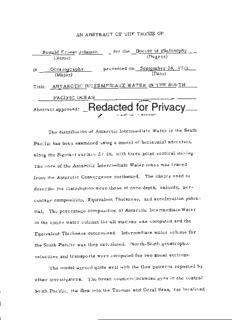
Antarctic intermediate water in the South Pacific Ocean PDF
Preview Antarctic intermediate water in the South Pacific Ocean
AN ABSTRACT OF THE THESIS OF Ronald Ernest Johnson for the Doctor of Philosoph (Degree) (Name) presented on September 28, 1971 in Oceanography (Date) (Major) Title: ANTARCTIC INTERMEDIATE WATER IN THE SOUTH PACIFIC OCEAN Redacted for Privacy Abstract approved: The distribution of Antarctic Intermediate Water in the South Pacific has been examined using a model of horizontal advection, along the Sigma-t surface 27. 10, with three point vertical mixing. traced The core of the A.ntarctic Intermediate Water mass was The charts used to from the Antarctic Convergence northward. describe the distribution were those of core depth, salinity, per- Thickness, and acceleration poten- centage composition, Equivalent tial. The percentage composition of Antarctic Intermediate Water in the entire water column for all stations was computed and the Intermediate water volume for Equivalent Thickness determined. the South Pacific was then calculated. North-South geostrophic velocities and transports were computed for two zonal sections. The model agreed quite well with the flow patterns reported by The broad counterclockwise gyre in the central other investigators. South Pacific, the flow into the Tasman and Coral Seas, the localized flow near New Zealand, and the suggestion of southward flow near A pre- the South American Coast are all indicated by the model. viously unreported small, counterclockwise gyre in the southeast South Pacific was detected. The circulation within the small gyre is consistent wity flow over a variable bottom in the Southern Hemis- phere. Antarctic Intermediate Water transport across selected sections indicate a northward flow of 10 x 10 m sec. A low salinity tongue was found on the salinity chart. This tongue extended northward, then westward, into the northern Tasman Sea. The salinity was over 34. 500/00 in the center of this counterclockwise motion east of New Zealand. The isohalines in the southeast Pacific suggest the presence of the small counterclockwise gyre. A 20 percent drop in core percentage composition was noted in the 10 de- grees north of the Antarctic Convergence. A large uniform area between 80 percent and 70 percent over the central portion of the central South Pacific was bounded on the north by a 20 percent drop near the equator, again supporting the general counterclockwise circulation. The Equivalent Thickness distribution showed a general lenticu- lar shape, the thickest part lying in the center of the counterclock- wise gyre east of New Zealand. The Equivalent Thickness distri- bution, as well as the core percentage, supported the hypothesis of little or no flow into the Tasman Sea from the south. The volume of intermediate water obtained from surface area integration of the Equivalent Thickness distribution was 59. 44 x 106 km3. This is approximately 16% of the water volume in the South Pacific. 1971 RONALD ERNEST JOHNSON ALL RIGHTS RESERVED Antarctic Intermediate Water in the South Pacific Ocean by Ronald Ernest Johnson A THESIS submitted to Oregon State University in partial fulfillment of the requirements for the degree of Doctor of Philosophy June l97Z APPROVED: Redacted for Privacy Profelsor of Oceanography In Charge of Major Redacted for Privacy Chaiiman of Departmnt of Oceanography Redacted for Privacy Dean of Graduate School Date thesis is presented September 8, 1971 Typed by Marcia Griffin for Ronald Ernest Johnson ACKNOWLEDGEMENTS I wish to thank my wife, Roberta, Miss Margaret Poole, and Miss Deecee Davenport who typed the first drafts; and Messrs. Dennis Barstow, Zvi Weinman, William Weiss, and Paul Moersdorf for the drafting of all thesis figures and charts. I also wish to thank Dr. June Pattullo for suggesting the thesis topic; Mr. Joe Reid for providing the opportunity to participate on a data collection cruise in the study area; and Mrs. Marcia Griffin who typed the thesis on short notice. The funding for the basic calculations was provided by a Bureau of Commercial Fisheries fellowship in ocean engineering and an Office of Naval Research Assistantship, Nonr 1286(1). TABLE OF CONTENTS Page INTRODUCTION 1 LITERATURE SURVEY 5 Introduction 5 Formation Zone S Distribution 9 Volume Determinations 17 MODEL AND DATA 26 Model 26 Introduction 26 Isentropic Analysis 29 Three Point Vertical Mixing 31 Data 47 ANTARCTIC INTERMEDIATE WATER DISTRIBUTION 49 Core Characteristics 49 Formation Position 49 Depth 49 Salinity 51 Percent Composition 52 Equivalent Thickness 56 Percent Composition With Depth 56 Equivalent Thickness Distribution 62 AAIW Volume 64 Volume Calculations 64 Volume Distribution 68 Page 72 L)YNAMIC CALCJLAT1ONS Geostrophic Velocities 72 Level of No Motion 72 Dynamic-Height Anomalies 73 Flow Direction 74 Velocity Magnitude Estimates 76 Geostrophic Transport 78 Section Locations 78 Relation to Percent AAIW Composition 79 82 SUMMARY AND CONCLUSIONS 84 RELATED PROBLEMS Movement of AAIW 84 Other Models 86 BIBLIOGRAPHY Literature Sources 89 Data Sources 99 APPENDICES 103 Sources of Oceanographic Stations 104 I Isentropic Analysis 110 II lii Derivation A. Example Acceleration Potential Calculation 116 B. Example Geostrophic Velocity Calculation 117 C. Ill Three-Point Mixing 120 Derivation 121 A. Example AAIW Percentages Calculation 123 B. Graphical Solution 124 C. Data Reduction Summary, Acceleration 126 IV Potential 127 Page 137 APPENDICES (Cont.) Data Reduction Summary, Percent Composition V and Equivalent Thickness 138 Vi Data Reduction Summary 148 Volume Calculations 149 Equivalent Thickness Modifiers 166
Description: